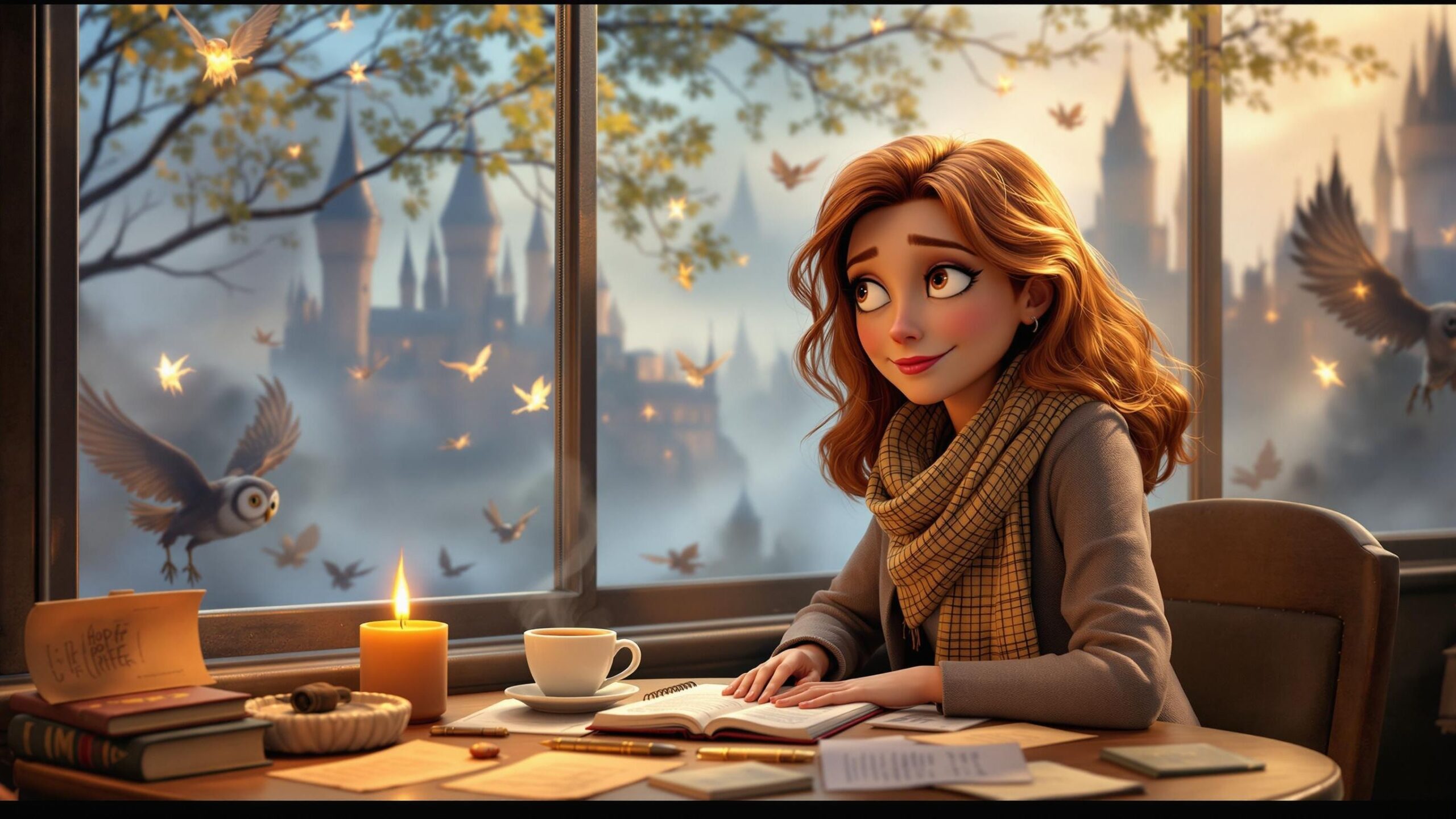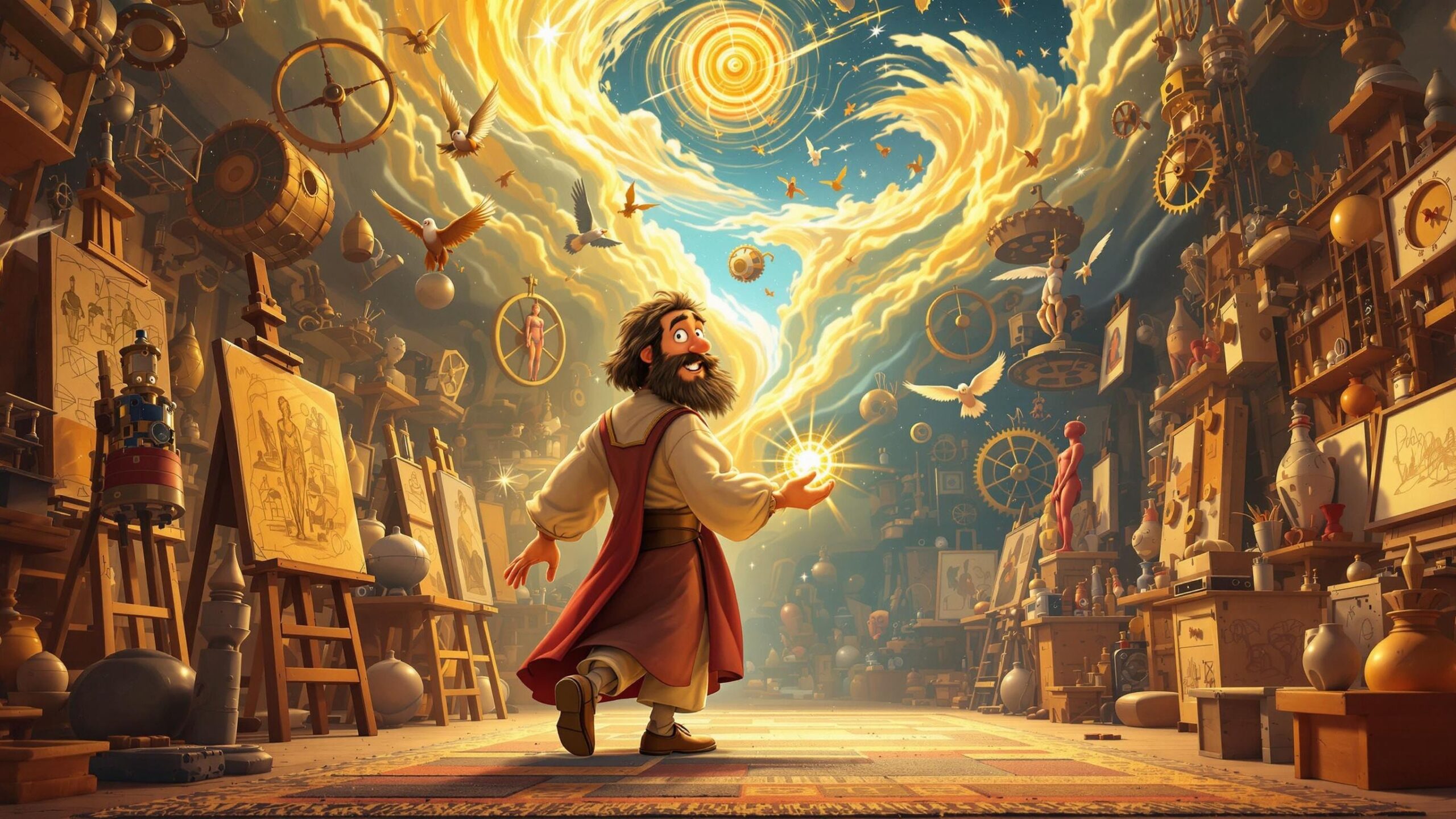J.K. Rowling didn’t just write a book—she built a world. One moment she was a single mother scribbling notes on café napkins; the next, she had conjured up a universe filled with spellbinding castles, flying broomsticks, and a boy wizard with a lightning-shaped scar. But the true magic of Rowling’s creation wasn’t just in the charms and creatures—it was in the beating heart of her storytelling. With Harry Potter, she gave readers across the globe a place to belong, grow, and believe in something more. Her journey from rejection slips to record-breaking success is as extraordinary as any tale she penned, and the world she imagined continues to enchant generations. This is the story of the woman whose pen became a wand—and whose words cast a spell that still hasn’t lifted.
A Lightning Bolt on a Train
The story of J.K. Rowling begins not in a grand castle, but on a delayed train from Manchester to London in 1990. Somewhere along those rattling tracks, a boy wizard wandered into her imagination—scruffy, skinny, and unaware of the destiny waiting for him. She had no pen. No paper. But she had a vision so vivid that the story of Harry Potter took root before it even had a name. That moment sparked a literary journey that would change her life—and global pop culture—forever.
Born Joanne Rowling in Yate, England, in 1965, Rowling always had an affinity for storytelling. She wrote fantasy tales for her younger sister as a child, filling pages with adventure and wonder. She studied French and the classics, worked for Amnesty International, and by her mid-twenties, had a head full of stories and a heart full of determination. But life didn’t hand her anything easily. She moved to Portugal, married and divorced quickly, and returned to the UK as a single mother, battling depression and financial hardship. She wrote in cafés while her baby daughter slept beside her, often hunched over a mug of coffee, hoping one day her words would matter.
And then they did.
The Philosopher’s Stone Breaks the Spell
Harry Potter and the Philosopher’s Stone wasn’t an overnight success—but it might be one of the most magical publishing stories of all time. Twelve publishers rejected the manuscript before a small company, Bloomsbury, took a chance on it. The editor reportedly gave the first chapter to his eight-year-old daughter, who devoured it and begged for more. That was all the spark they needed.
When it finally hit shelves in 1997, Rowling’s debut novel didn’t just sell—it soared. Children who had never loved reading suddenly couldn’t put the book down. Parents were sneaking chapters after bedtime. Teachers were reading it aloud in classrooms. The story had charm, wit, mystery, and most of all, heart. Rowling hadn’t just written about wands and wizards—she’d written about friendship, courage, and finding light in the darkest places.
The Harry Potter books didn’t talk down to young readers. They trusted them. They gave them a complex world with rules, politics, history, and consequences. And Rowling wrote each book as if the children reading them were growing up with Harry—because they were.
Hogwarts: The School of Everyone’s Dreams
More than any spell, creature, or enchanted artifact, Rowling’s most iconic creation might be Hogwarts School of Witchcraft and Wizardry. It wasn’t just a backdrop—it was a character. A castle full of mystery and warmth, danger and discovery. With its shifting staircases, talking portraits, and ghostly residents, Hogwarts felt both ancient and alive. Every reader had a house they felt drawn to, a class they wanted to take, a secret hallway they longed to explore.
Rowling understood the power of longing. Hogwarts became a symbol of home for readers who didn’t feel like they belonged elsewhere. It wasn’t just a school—it was a sanctuary. The magic was brilliant, but the relationships were the heart. Hermione’s brains, Ron’s loyalty, Hagrid’s warmth, Dumbledore’s wisdom—they gave readers companions they could carry for life.
And Rowling infused this world with her own sharp observations. House-elves, blood purity, the Ministry of Magic—these weren’t just fantasy concepts, they mirrored real-world themes of oppression, prejudice, and corruption. Hogwarts was escapism, but it was also a lens through which young readers learned to navigate the world.
The Series Grows Darker—and So Does the World
As the books progressed, Rowling let the story deepen and darken. The Chamber of Secrets brought themes of identity and fear. The Prisoner of Azkaban introduced injustice and trauma. By The Goblet of Fire, death had arrived—and with it, a more complex moral universe. Each book raised the stakes emotionally, politically, and philosophically.
What set Rowling apart was her fearlessness. She didn’t flinch from grief, betrayal, or war. She allowed beloved characters to die. She showed that evil wasn’t just Voldemort with his snake-like face—it was apathy, propaganda, and the refusal to stand up when it mattered. The Order of the Phoenix and The Half-Blood Prince pulled readers into a world where resistance meant sacrifice, and The Deathly Hallows wrapped it all with heartbreak, hope, and quiet heroism.
Rowling grew with her readers. She trusted them with loss and complexity, and in return, they clung to her stories with fierce loyalty. For many, Harry’s battle wasn’t just fiction—it mirrored their own coming-of-age struggles. Rowling had created more than characters. She had created companions.
The Phenomenon Spreads Its Wings
The wizarding world didn’t stay confined to pages for long. In 2001, Harry Potter and the Sorcerer’s Stone (retitled for American audiences) hit the big screen, and Daniel Radcliffe, Emma Watson, and Rupert Grint became household names. The films brought the magic to life, building on Rowling’s vision while adding their own cinematic flair. Audiences of all ages flooded theaters, dressed in robes and waving wands, ready to return to Hogwarts again and again.
Theme parks, merchandise, fan sites, cosplay conventions, podcasts, and spin-offs followed. Rowling had not just written a story—she had founded a culture. Fans bonded online, debated fan theories, wrote their own fiction, and queued for midnight book releases with lightning bolts drawn on their foreheads. The magic had become a movement.
But through it all, Rowling remained the architect. She had mapped out seven books from the beginning, and she stayed true to her vision. She wove subtle clues across volumes, planted seeds that wouldn’t bloom for years, and crafted a world so intricate that fans are still decoding it decades later.
The Power Behind the Pen
What made Rowling’s writing so powerful wasn’t just the plot—it was her voice. Her prose was witty and sharp, often laugh-out-loud funny, and rich with texture. She understood how to balance light and shadow, mixing high-stakes battles with charming quirks, and heartache with humor. Her characters weren’t flat archetypes—they were layered, flawed, and utterly human. Even minor figures had depth and memorable lines.
Her villains were terrifying not just because they had power, but because they represented real fears. Dolores Umbridge was a pink-clad nightmare of bureaucracy and cruelty, while Bellatrix Lestrange was chaos personified. Even Voldemort, with all his snake-like menace, was just a boy who feared death too much to live honestly.
Rowling’s greatest triumph, though, might be in the characters who weren’t chosen ones. Neville Longbottom, Luna Lovegood, Molly Weasley—these were the quiet heroes who proved that bravery comes in all shapes. She created a world where readers could see themselves—not as perfect, but as people who mattered.
Beyond the Final Page
When The Deathly Hallows concluded the series in 2007, millions of readers wept—not just for the characters lost, but for the end of a journey they’d taken alongside Rowling for a decade. But endings are rarely final in fantasy.
Rowling continued to explore the wizarding world through Fantastic Beasts, a spin-off film series set in the 1920s. She penned The Cursed Child, a stage play imagining Harry’s life as a parent. She launched Pottermore, offering fans deeper lore and character histories. While not every post-Harry project landed with the same magic, Rowling’s desire to expand the universe showed her commitment to the world she’d built—and to the fans who had loved it.
She also turned to adult fiction under the pseudonym Robert Galbraith, showing a grittier, crime-focused side of her storytelling. Though these works were more grounded, they still bore her hallmark: deeply drawn characters, layered plots, and sharp observations.
A Complicated Legacy
As with many public figures, Rowling’s legacy is complex. In recent years, some of her comments on social issues—particularly regarding gender identity—have sparked intense controversy and division among fans and fellow authors alike. Some readers have struggled to reconcile the world of acceptance and diversity she created with statements they view as exclusionary or harmful.
This debate has led many to reexamine what it means to separate art from artist, and whether the stories we grow up with can—and should—evolve with us. For others, the books remain a safe place, unchanged by the creator’s public stances. What’s undeniable is that Rowling’s impact on literature, culture, and an entire generation of readers is monumental.
She opened the door to fantasy for millions who had never considered themselves readers. She inspired a wave of authors to explore magical worlds, complex themes, and emotionally rich narratives. Whether embraced or critiqued, her name continues to ignite conversation—and her world continues to be lived in.
Conclusion: The Magic That Endures
J.K. Rowling didn’t just write a fantasy series. She created a literary lightning bolt that struck millions of readers and left a scar in the shape of a story. Harry Potter was more than fiction—it was a cultural experience, a rite of passage, a bond between generations. Its legacy isn’t just in pages or box office numbers, but in the friendships it sparked, the imaginations it fueled, and the belief it planted that even ordinary people can do extraordinary things.
Through her words, Rowling gave readers a place to grow, question, and dream. The world she built still stands—tall towers, enchanted portraits, moving staircases, and all—ready for the next curious soul to wander in. Because at the end of the day, that’s the real magic: the kind that lives in stories. The kind that never needs a wand.




